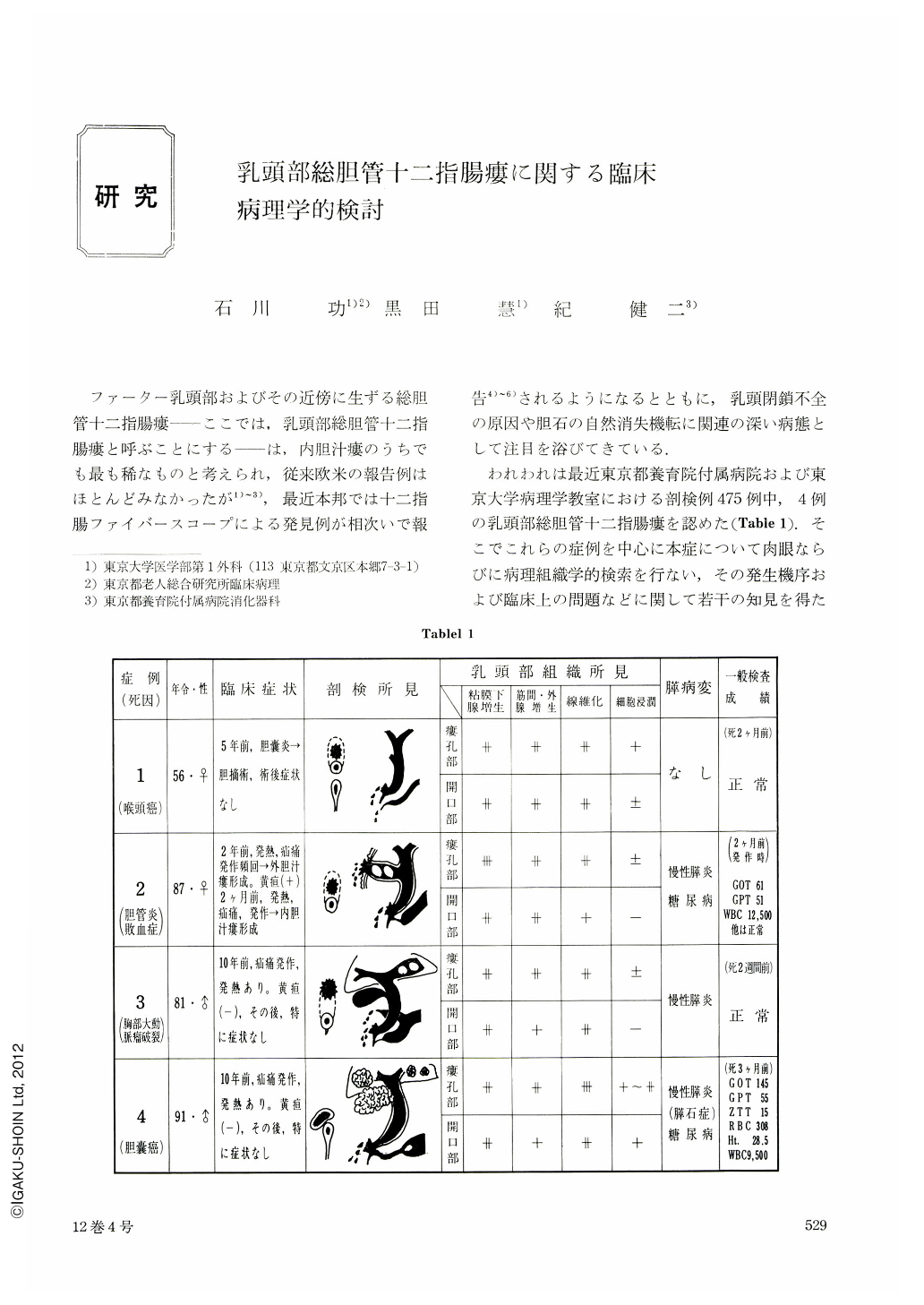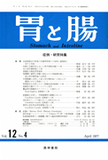Japanese
English
- 有料閲覧
- Abstract 文献概要
- 1ページ目 Look Inside
ファーター乳頭部およびその近傍に生ずる総胆管十二指腸瘻──ここでは,乳頭部総胆管十二指腸瘻と呼ぶことにする──は,内胆汁瘻のうちでも最も稀なものと考えられ,従来欧米の報告例はほとんどみなかったが1)~3),最近本邦では十二指腸ファイバースコープによる発見例が相次いで報告4)~6)されるようになるとともに,乳頭閉鎖不全の原因や胆石の自然消失機転に関連の深い病態として注目を浴びてきている.
われわれは最近東京都養育院付属病院および東京大学病理学教室における剖検例475例中,4例の乳頭部総胆管十二指腸瘻を認めた(Table 1).そこでこれらの症例を中心に本症について肉眼ならびに病理組織学的検索を行ない,その発生機序および臨床上の問題などに関して若干の知見を得たので報告する.
Spontaneous choledocho-duodenal fistulation in the area of the papilla of Vater (Vaterian choledocho-duodenal fistulation, VCDF) is one of the rarest examples of the internal biliary fistulation and has not been reported in Euro-American literature by this time.
In recent years, the reports dealing with the presence of VCDF have been increasing parallel to a progress of endoscopical techniques in Japan. The alteration may be falsely diagnosed as a incontinence of Oddi's sphincter or is considered as possible pathway to explain spontaneous disappearance of gallstones.
In this paper, clinico-pathological data of four VC DF cases experienced in our recent 475 autopsy are reported and its pathogenesis is discussed.
1) The ages of patients at the time of fistulation estimated from the clinical records are rather old (51~81 yrs.) roughly corresponding to those other enterobiliary fistulation reported in the literature. At the onset of fistulation, fever and right hypochondral colic in all four cases and jaundice in two were noted. Choledocholithiasis was likely the primary etiologic factor of VCDF in all cases.
2) The VCDF of all four cases occurred from the intramural bile duct to the duodenal mucosa in locations about 5~8 mm oral from the orifice of the major papilla. Grossly the fistular orifices were detected from the duodenal mucosal side in the longitudinal fold of the papilla of Vater in two cases but not cleary identified in the other two.
3) Histologically significant glandular proliferation of submucosal and intra and extra-muscular areas (adenomyomatous proliferation), fibrosis and infiltration of small round cells were noted in the area of the papilla of Vater.
The alterations were more significant at or around the fistular orifice than the peri-ductal area of the original bile duct.
Remnants of Oddi's sphincter were noted around the choledochus of hepatic side from the fistula in all cases. It is speculated that the degree of the sphincter damage may relate to clinical manifestation of the reflux of duodenal contents and air into the bile duct.
4) Various factors, such as the descending gallstone, anatomical relation between the terminal bile duct and the duodenum and histological alteration of the papilla of Vater due to aging and cholelithiasis, are very important in pathogenesis of VCDF. This conclusion was further confirmed by a comparative study on additional three reference cases.
5) Following serious complications were noted in three cases; fatal cholangitis by remaining gallstones in 1, chronic pancreatitis with diabetes mellitus in 2 carcinoma of the gallbladder in 1. Though the direct contribution of fistulation to these complications is not clear, careful follow-up and the proper surgical treatments of the patients in VCDF is very important to prevent serious complications.

Copyright © 1977, Igaku-Shoin Ltd. All rights reserved.


